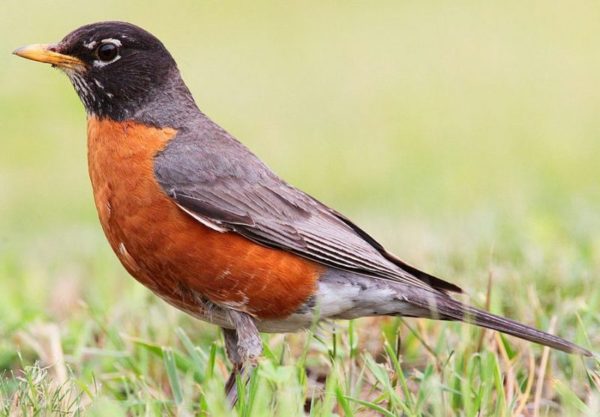Information About The Bird
Seen/Heard at
Decorah, Decorah North, Great Spirit Bluff
Diet
Look for American Robins wherever the food is. During the summer, robins eat large numbers of invertebrates, searching for worms and beetles on the ground in the morning and moving higher into trees as the day warms and insects rise. As invertebrates become less available in fall, winter, and early spring, robins forage for dried fruit in trees and bushes, including cedar berries, juniper berries, hackberry, service berry, chokecherries, hawthorn, dogwood, and sumac fruits. Although fish isn’t on the list of ‘things robins eat’, birder Sharon Steitler (aka the Birdchick) has also seen them foraging around bait shops for dead minnows. According to Cornell, robins may try to round out their diet by selectively eating fruit that contains bugs – a two-for-one combo rich in sugar, protein, fat, and calcium. They also sometimes take shrews, small snakes, and aquatic insects.
Nesting
Female robins build nests by pressing dead grass, twigs, paper, feathers, rootlets, moss, and other materials into a cup shape using the wrist of one wing. They reinforce their nests with mud and line them with soft grass. Egg laying usually begins in April or (in some northern or high elevation areas) May, and nesting may continue into July. Robins lay three to five light blue eggs per clutch and produce up to three broods per year. Females incubate eggs for 12-14 days and both parents tend young, which leave the nest 14-16 days after hatching. To learn more, visit Cornell’s website.
Many things influence egg shapes and colors. Why do American Robins have sky blue eggs? You can read more about that here: http://bit.ly/2pvtoDj
Citations
Bird Range Maps of North America
Ridgely, R.S., T.F. Allnutt, T. Brooks, D.K. McNicol, D.W. Mehlman, B.E. Young, and J.R. Zook. 2003.
Digital Distribution Maps of the Birds of the Western Hemisphere, version 1.0. NatureServe, Arlington, Virginia, USA. Data provided by NatureServe in collaboration with Robert Ridgely, James Zook, The Nature Conservancy – Migratory Bird Program, Conservation International – CABS, World Wildlife Fund – US, and Environment Canada – WILDSPACE.
Web Link: http://bit.ly/2ynPQ5I
General Description
Upper side dark gray with a darker head; rusty-orange breast and flanks; white spots around eye; dark tail with or without white outer corners. Adult male is darker than adult female and has a darker orange breast. Juveniles have a dark-spotted orangish breast.
Migration
Resident to short-term migrant. Although American Robins are considered a sign of spring, they can be found in the Decorah area year-round. Some winter robins could be migrants from colder northern areas.
Measurements
Length
7.9–11 in/20–28 cm
Wingspan
12.2–15.7 in/31–40 cm
Weight
2.7–3 oz/77–85 g
Wing Design
Elliptical. Optimized for bursts of fast, tightly controlled flight. Excellent at taking off quickly, maneuvering through branches, and avoiding predators.
Videos
[/full]
